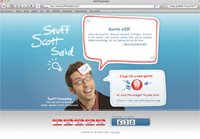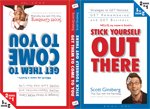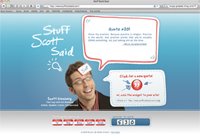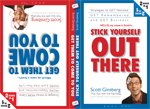 You can’t bastardize “caring” into a technique.
You can’t bastardize “caring” into a technique.
There’s no formula.
There’s no handbook.
There’s no seven-step system.
It’s not about doing it the right way – it’s more about your willingness TO care, you awareness OF caring, and consistency with which you DO care.
THE HARD PART IS: Caring takes a lot of work.
If you’re up to the challenge, here’s a list of ideas that might help:
1. Bother to do things. To come. To call. To stay. To ask. To reply. To say hi. To clean up. To give it some thought. To include people. To learn their names. (Just to name a few.) Learn to befriend simplicity. You’ll discover that the beauty to caring is found is in the basic.
The challenge is not overlooking these moments just because you think nobody notices. They do. My suggestion is to keep a running list of any time you hear somebody start a sentence with the phrase, “You didn’t even bother to…” Then go out of your way to avoid those things. Do you bother to bother?
2. Mind the ratio. Caring is like epoxy glue: It only takes a few drops to hold something together. Next time you’re debating whether or not to care, remember how beautifully imbalanced the cause/effect ratio is. For example, whenever I would visit my grandma Mimi at her senior living community, she would spend the next three weeks telling everyone she knew – plus a few people she didn’t know – about our time together.
You’d think I discovered the cure for cancer. But all we did was have dinner. That’s when I learned a valuable lesson: It’s SO easy to make people happy. All you have to do is ask yourself: What’s this person’s epoxy?
Of course, then comes the hard part: Taking the initiative to care. And my best suggestion for overcoming inertia is to constantly replay mental reruns of past moments when the caring ratio exploded. That’s all the motivation you’ll need. Do you have the courage to care?
3. Care for the right reasons. I swear: Some people spend an awful lot of time, money and energy trying to convince others that they care. Which, technically, is a form of caring. My question is: Why are they caring? Because it’s (actually) important to them, or because they know it makes other people feel good? Because it’s (truly) an expression of their feelings, or because they have an agenda attached?
I’m not trying to be cynical – just aggressively skeptical. Personally, I’d rather you not care than care falsely.
Then at least you’d be telling me the truth, as opposed to sending me one of those disturbing greeting cards with my own picture on the cover that you “customized” with that phony cursive font so I would think you actually sat down by candle light and used an fountain pen to tell me how much you cared, when what you really care about is recruiting me into the downline of your multi-level marketing company. Do you (really) care, or just care about looking like you care so you can meet your sales quota?
4. Learn from the best. Companies That Care is a not-for-profit organization dedicated to enhancing the well being of employees. According to their mission, ten characteristics define the standard for all organizations desiring to be recognized as caring, responsible institutions. They include:
*Sustain a work environment founded on dignity and respect for all employees
*Make employees feel their jobs are important
*Cultivate the full potential of all employees
*Encourage individual pursuit of work/life balance
*Enable the well-being of individuals and their families through compensation, benefits, policies and practices
*Develop great leaders, at all levels, who excel at managing people as well as results
*Appreciate and recognize the contributions of people who work there
*Establish and communicate standards for ethical behavior and integrity
*Get involved in community endeavors and/or public policy and finally
*Consider the human toll when making business decisions.
That should keep you busy for a while. How well do you and your organization model those characteristics of caring?
5. Practice selective neglect. If you spend too much time caring about things you shouldn’t care about, the things you should be caring about will fall apart. And then you really will care. It’s all about discretion. For example, I tell the members of my mentoring program, “I care less about where you go and more about who you become while you’re getting there.”
That’s my filter as a mentor. Your mission is to create a similar filter to gauge the “care currency” of your endeavors. You might try questions like: Does this relationship nourish me? Is this experience going to help me become the best, highest version of myself? And ten years from now, what will I wish I had spent more time doing today? Remember: Part of caring is knowing what (not) to care about. What’s your compass for finding what matters?
6. Become an attention expert. Care means paying attention. Period. Simplest definition possible. Here are a few specific suggestions for doing so: First, concentrate attention wonderfully. Example: My yoga instructor often reminds us to pick a spot on the ceiling to focus on during class. This keeps our attention “in the room.” Interestingly, this same practice can be applied off the mat. Challenge yourself to fight those A.D.D. urges during your meetings and conversations. People will know you care.
Secondly, manage attention superbly. Notice where it leaks. Step outside of yourself and watch for when you nod off. Example: I reinforce this practice during the editing phase of my training videos for NametagTV. Whenever I preview a module before its online publication, I spy on myself. If, at any time, I start tuning out, picking my nose or fiddling with my iPhone, I stop and return to center. Practice reminding yourself to manage your attention and people will notice. Are you an expert at your attention tendencies?
7. Show up when you’re scared. This proves to people that you’re a human being. That you’re willing occupy your vulnerability. And that your desire to care overrides your need to be confident. For example, if someone you love is going through a tough time that you can’t relate to (or empathize with), show up anyway. In your pajamas at 2am if you have to.
Then, practice breathing through that fear. Listen loudly. Take notes. Reflect their reality back to them. And remember that it’s okay to say, “I don’t know what to say.” Remember: Presence trumps eloquence. The height of caring is the intersection of vulnerability and naked honesty. Are you willing to sacrifice comfort for caring?
8. Respond to people’s emotions first. Acknowledgement is a universal human need. And listening is (initially) about laying a foundation of affirmation. Your challenge is to make people feel more than just valued, validated and important; but essential.
Before launching into your solutions, try priming your responses with Phrases That Payses like, “Wow, that’s a tough situation you must be going through,” and “You must be so frustrated.” Or, if words aren’t going to get the job done, do what I do: Just give her a hug and stop trying to explain the meaning of the universe. Are you fundamentally affirmative?
9. Make it tangible. Finally, never overestimate the power of the tangible. Even if it’s a scrap of paper with a two-line message that you slip into somebody’s daily planner when she’s not looking. Physically giving somebody something (that you went out of your way to obtain) – even if it only took two minutes to do so – never goes unappreciated.
But I don’t know why. Maybe there’s something especially powerful about tangibility. Maybe people just like stuff. Either way, it doesn’t matter what you bring for someone – only that you bring it. How will you personify your desire to care?
Look, I know it’s a lot to ask someone to care. Even I struggle with this practice myself from time to time.
But, as our world gets louder, as our technology becomes faster and as our lives grow busier, maybe caring is just what the doctor ordered.
LET ME ASK YA THIS…
Do you dare to care?
LET ME SUGGEST THIS…
For the list called, “6 Ways to Out POSITION Your Competitors,” send an email to me, and I’ll send you the list for free!
* * * *
Scott Ginsberg
That Guy with the Nametag
Author, Speaker, Coach, Entrepreneur
[email protected]
 Who’s quoting YOU?
Who’s quoting YOU?
Check out Scott’s Online Quotation Database for a bite-sized education on branding success!

 1. Applicability is the bridge between information and insight. Anyone can be a vending machine of good information. Only a true thought leader could bridge the gap. The difference is: Information is just content; insight is a penetrating mental vision. Which one do you deliver?
1. Applicability is the bridge between information and insight. Anyone can be a vending machine of good information. Only a true thought leader could bridge the gap. The difference is: Information is just content; insight is a penetrating mental vision. Which one do you deliver? The world’s FIRST two-in-one, flip-flop book!
The world’s FIRST two-in-one, flip-flop book! Abrasives. Automotive accessories. Bearings. Building supplies. Cattle. Chemicals. Coffee beans. Computer Hardware. Converters. Envelopes. Fertilizer. Grain. Industrial metals. Insurance. Laboratory equipment. Minerals. Oil. Office supplies. Precious metals. Salt. Soybeans. Sugar. Textiles. Wheat. Wool.
Abrasives. Automotive accessories. Bearings. Building supplies. Cattle. Chemicals. Coffee beans. Computer Hardware. Converters. Envelopes. Fertilizer. Grain. Industrial metals. Insurance. Laboratory equipment. Minerals. Oil. Office supplies. Precious metals. Salt. Soybeans. Sugar. Textiles. Wheat. Wool. 
 “Wow, that takes balls.”
“Wow, that takes balls.” The world’s FIRST two-in-one, flip-flop book!
The world’s FIRST two-in-one, flip-flop book!
 There’s a fine line between boundary management and self-righteous entitlement.
There’s a fine line between boundary management and self-righteous entitlement. After an hour of deliberation, I couldn’t come up with a clever way to start this blog post.
After an hour of deliberation, I couldn’t come up with a clever way to start this blog post. Who’s quoting YOU?
Who’s quoting YOU? 1. “Don’t put all your eggs in one basket.”
1. “Don’t put all your eggs in one basket.” “Morning Karen! I just wanted to personally thank you for taking the time out of your busy schedule yesterday to talk to me about the Senior Toilet Cleaning position with The Packlebush Proctology Clinic.
“Morning Karen! I just wanted to personally thank you for taking the time out of your busy schedule yesterday to talk to me about the Senior Toilet Cleaning position with The Packlebush Proctology Clinic.  Being an entrepreneur is risky.
Being an entrepreneur is risky. The world’s FIRST two-in-one, flip-flop book!
The world’s FIRST two-in-one, flip-flop book!